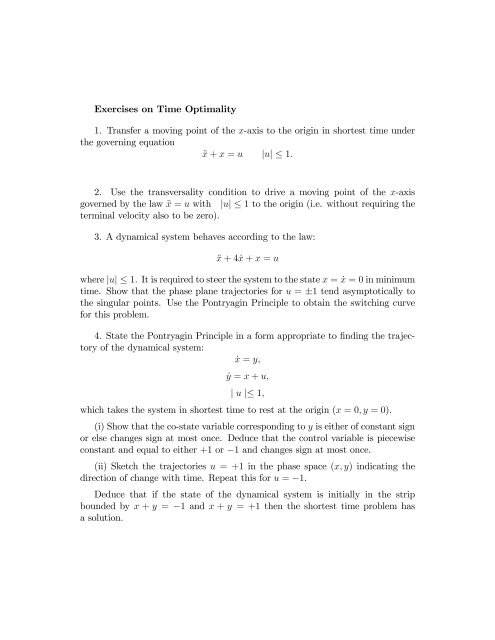Exercises on time optimality control
Exercises on time optimality control
Exercises on time optimality control
- No tags were found...
Create successful ePaper yourself
Turn your PDF publications into a flip-book with our unique Google optimized e-Paper software.
<str<strong>on</strong>g>Exercises</str<strong>on</strong>g> <strong>on</strong> Time Optimality1. Transfer a moving point of the x-axis to the origin in shortest <strong>time</strong> underthe governing equati<strong>on</strong>x + x = u juj 1:2. Use the transversality c<strong>on</strong>diti<strong>on</strong> to drive a moving point of the x-axisgoverned by the law x = u with juj 1 to the origin (i.e. without requiring theterminal velocity also to be zero).3. A dynamical system behaves according to the law:x + 4 _x + x = uwhere juj 1. It is required to steer the system to the state x = _x = 0 in minimum<strong>time</strong>. Show that the phase plane trajectories for u = 1 tend asymptotically tothe singular points. Use the P<strong>on</strong>tryagin Principle to obtain the switching curvefor this problem.4. State the P<strong>on</strong>tryagin Principle in a form appropriate to …nding the trajectoryof the dynamical system:_x = y;_y = x + u;j u j 1;which takes the system in shortest <strong>time</strong> to rest at the origin (x = 0; y = 0).(i) Show that the co-state variable corresp<strong>on</strong>ding to y is either of c<strong>on</strong>stant signor else changes sign at most <strong>on</strong>ce. Deduce that the c<strong>on</strong>trol variable is piecewisec<strong>on</strong>stant and equal to either +1 or 1 and changes sign at most <strong>on</strong>ce.(ii) Sketch the trajectories u = +1 in the phase space (x; y) indicating thedirecti<strong>on</strong> of change with <strong>time</strong>. Repeat this for u = 1.Deduce that if the state of the dynamical system is initially in the stripbounded by x + y = 1 and x + y = +1 then the shortest <strong>time</strong> problem hasa soluti<strong>on</strong>.
5. State the P<strong>on</strong>tryagin Principle in a form suited to deriving the trajectoryof minimum <strong>time</strong> taking the dynamical system with governing equati<strong>on</strong>:x = 5 _x 6x + u; juj 1from a given initial state to rest at the origin (i.e. x = 0; _x = 0).Use the P<strong>on</strong>tryagin Principle to show that the optimal c<strong>on</strong>trol is of ‘bang-bang’type and that at most <strong>on</strong>e switch of c<strong>on</strong>trol takes place.Find the singular points in the (x; _x) phase plane corresp<strong>on</strong>ding to the twoc<strong>on</strong>stant c<strong>on</strong>trols u = 1 and the linear trajectories through them. By c<strong>on</strong>sideringthe eigenvalues of the associated …rst-order formulati<strong>on</strong> say what shape oftrajectories to expect in general. Show that all trajectories for each of the twoc<strong>on</strong>trols u = 1 except <strong>on</strong>e approach a singular point tangentially to just <strong>on</strong>e ofthe linear trajectories.Sketch the trajectories u = 1 which pass through the origin of the phaseplane. Sketch also the switching curve, being careful to indicate how it is used toobtain optimal trajectories from any initial state in the phase plane.6. Discuss the <strong>time</strong> <strong>optimality</strong> problem for the dynamical system:x = 2x 3 _x + u; juj 1:7. Discuss the <strong>time</strong> <strong>optimality</strong> problem for the dynamical system:x = 1 (x + _x) + u; juj 1:68. If v 1 ; v 2 are the eigenvectors of A, show that the linear trajectories are inthe directi<strong>on</strong>s v 1 ; v 2 . (See hint below.)9. When the eigenvalues of A are distinct, show that A is symmetric, if and<strong>on</strong>ly if, the eigenvectors of A are orthog<strong>on</strong>al, if and <strong>on</strong>ly if, the linear trajectoriesare orthog<strong>on</strong>al.
Hint: With respect to the basis of eigenvectors the dynamical system is: X _ 1 0 X1=_X 2 0 X 2and X 1 = 0 and X 2 = 0 are then the linear trajectories, e.g. for X 1 = 0 x1= Xx 2 v 2 (X 2 2 R)2etc. and if v 1 ; v 2 are orth<strong>on</strong>ormalis symmetric.A = (v 1 ; v 2 ) 00 (v 1 ; v 2 ) T10. Verify the result of the last exercise, by reference to the matrix a bA =c das follows. Working with the singular point as origin, write x 1 = Be t + Ce t ,compute appropriate k; l from a; b; c; d such that x 2 = kBe t + lCe t . Observethat the linear trajectories are: x 2 = kx 1 (for C = 0) and x 2 = lx 1 (for D = 0).These are orthog<strong>on</strong>al when kl = 1.11. Assuming the eigenvalues of A are negative show that the trajectorieswith u = 1 are all but <strong>on</strong>e tangential to a linear trajectory passsing through thesingular point, the excepti<strong>on</strong>al trajectory being the other linear trajectory.Other things to do1. Use Plot and ParametricPlot in Maple (or Mathematica) to derive theshapes of trajectories.2. Investigate trajectories for the case of repeated eigenvalues. Plot the curvesy = c log x x and y = x + k log jxj.
















